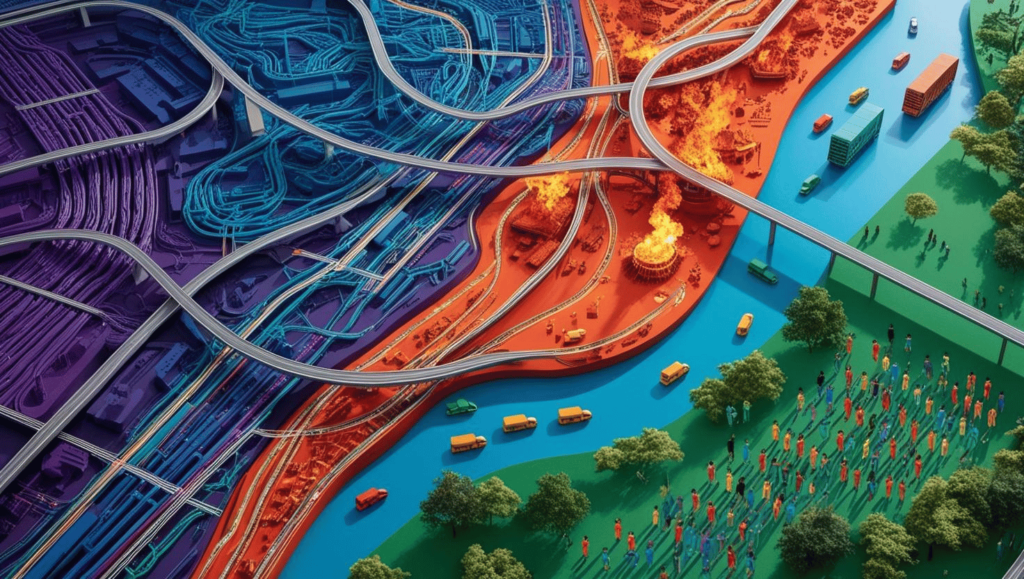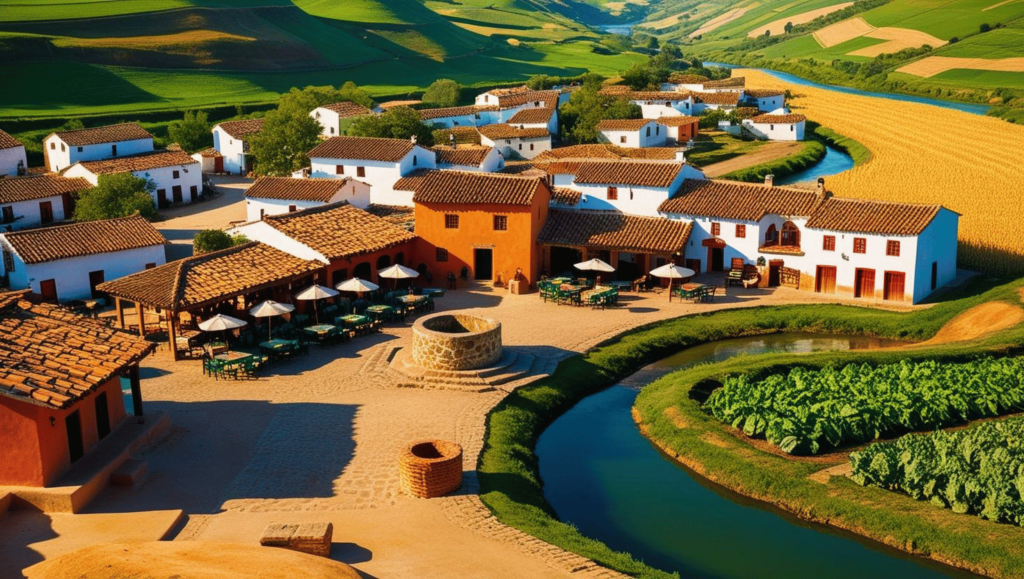Human geography is a subfield of geography that focuses on the study of human interactions with the environment, emphasizing the social, cultural, economic, and political aspects that shape human behavior and societal structures. It serves as a critical bridge between the natural world and the social sciences, facilitating a deeper understanding of how individuals and communities relate to their spatial surroundings. The essence of human geography lies in its analysis of spatial relationships, providing insights into how geographical factors influence social practices and economic activities.
One of the defining features of human geography is its interdisciplinary approach. It incorporates theories and methodologies from sociology, anthropology, economics, and political science, creating a holistic perspective on human activities. This interdisciplinary nature allows for the examination of various themes such as urbanization, migration patterns, cultural landscapes, and the socio-economic dynamics of different regions. By studying these elements, human geography unveils the complexities of human life as it interacts with the physical environment.
The significance of human geography is underscored by its ability to inform policy and planning. Understanding how societies utilize space and resources is essential for addressing critical challenges such as population growth, environmental degradation, and inequalities in resource distribution. Furthermore, human geography aids in recognizing the cultural dimensions of these issues by considering varying cultural values and historical contexts that shape local responses to global phenomena.
In essence, human geography offers vital tools for comprehending the interplay between society and its environment. It prompts inquiries about not only where people live, but also why they occupy specific locations and how their behavioral patterns influence the broader economic and cultural landscape. By exploring these spatial relationships, human geography plays a pivotal role in illuminating the intricate connections that define our world.
Sociology and Spatial Organization

Human geography serves as a vital framework for understanding the spatial organization of societies. It investigates the intricate relationship between people and their environments, analyzing the geographical factors that influence how communities develop and evolve over time. The spatial distribution of populations is heavily shaped by a myriad of elements, including economic opportunities, cultural practices, and social structures. By examining these factors, human geography can provide insights into why certain areas are densely populated while others remain sparsely inhabited.
Cultural norms significantly influence where individuals choose to live and how spaces are utilized. For instance, closely-knit communities often arise in regions where cultural traditions emphasize family ties and social cohesion. Such communities may prioritize communal spaces, leading to a spatial organization that fosters interaction among residents. Conversely, societies that value independence and personal space might exhibit more dispersed living patterns, where land use is dictated by individual preferences rather than collective needs. This variation in spatial organization is evident across different cultural landscapes, from urban centers characterized by high-rises and shared amenities to rural areas featuring expansive private properties.
Moreover, social structures play a crucial role in determining land use. Economic stratification affects residential patterns, with wealthier populations often residing in upscale neighborhoods, thereby segregating social groups spatially. Similarly, marginalized communities may find themselves concentrated in underprivileged areas, highlighting the disparities that arise from existing social hierarchies. By analyzing these layouts, human geography sheds light on how societal factors converge, impacting land use, community design, and ultimately, the spatial arrangements we observe in different environments.
Economic Interactions: Space and Industry
The relationship between geography and economics has significant implications for how industries develop and thrive. Economic interactions are profoundly influenced by the geographical distribution of resources, infrastructure, and human capital. Industries tend to cluster in specific areas, often referred to as economic hotspots, which facilitate trade and enhance economic growth. Understanding these dynamics offers insights into the global economy and local development.
Geographical considerations play a crucial role in determining where industries are established. For example, natural resources such as minerals, forests, and water bodies greatly influence the location of manufacturing and extractive industries. Regions rich in resources often attract businesses looking to capitalize on these assets, leading to the development of industrial hubs. This clustering effect not only increases efficiency in production but also promotes innovation as businesses benefit from shared knowledge and resources.
Moreover, economic hotspots often emerge in areas with strategic advantages such as access to major transportation routes or ports. These attributes reduce costs and enhance connectivity for trade, fostering an environment where industries can flourish. The result is an interconnected web of economic activities that affect local and national economies. For instance, Silicon Valley in the United States is a prime example, where technological firms have congregated due to a favorable climate for innovation, venture capital availability, and a skilled labor pool.
Additionally, the implications of resource distribution extend to global trade. Regions that are resource-rich are often exporters, while others may depend on these imports to support their industries. This interdependence highlights the necessity of efficient resource allocation and trade agreements to maintain economic stability. Thus, the interplay of geography and economy not only drives industry location but also shapes the broader economic landscape. Understanding these relationships can guide policymakers in fostering sustainable economic development.
Political Geography: Boundaries and Power

Political geography serves as a critical framework for understanding how human interactions and governance are shaped by territorial boundaries and power structures. The delineation of political boundaries plays a significant role in determining the social fabric and economic relations within and between nations. These boundaries can influence a range of factors, including resource allocation, trade partnerships, and cultural exchanges, ultimately determining societal interactions.
In many instances, political boundaries are shaped by historical contexts, territorial claims, and even colonial histories. For example, the drawing of borders post-colonization often disregarded ethnic, cultural, and linguistic divisions, leading to social discord and conflict in many regions. Such divisions can exacerbate existing geopolitical tensions, resulting in strained relationships between nations and communities. In contrast, more integrated political landscapes may facilitate trade and cooperation, enhancing economic outcomes and fostering positive social interactions.
The impact of geopolitical alliances cannot be overlooked. Countries that find common ground tend to establish collaborations that can lead to shared economic benefits. In situations where political power is centralized, governance may skew the distribution of resources, favoring particular groups over others. This can lead to social unrest as marginalized communities react to perceived injustices within their societies.
Furthermore, political geography also plays a role in the contestation of boundaries, where issues such as territorial disputes can escalate tensions between neighboring countries. The consequences of these geopolitical challenges are far-reaching, as they not only influence economic relations but also have broader implications for international relations, stability, and peace.
Ultimately, understanding the dynamics of political geography is essential for comprehending how power structures affect societal interactions and governance, allowing for a more nuanced view of the interconnectedness of society, culture, and economy.
Cultural Landscapes: The Intersection of Geography and Identity

Cultural landscapes serve as a vivid representation of the ways in which human geography intertwines with individual and collective identities. These landscapes are not merely the physical spaces we inhabit; they are reflections of the customs, values, and stories carried by various cultures. The geographical elements of a region, including its climate, topography, and natural resources, significantly mold the lifestyles and practices of its inhabitants, contributing to a unique cultural landscape that embodies the identity of the community.
The built environment is a prominent aspect of cultural landscapes, where architecture acts as a powerful medium of expression. Historical structures, religious buildings, and community centers not only fulfill practical needs but also symbolize the cultural heritage and ethos of a society. For instance, in areas with a rich historical background, such as ancient towns or cities, architectural styles are markers of cultural influence, power dynamics, and even socio-political shifts over time. These elements illustrate how geography shapes cultural outputs, making architecture an integral part of the cultural landscape.
Land usage is another essential component that reflects cultural identities. Agricultural practices, urban planning, and the distribution of public spaces are deeply intertwined with geography. Communities adapt their land utilization practices according to the environmental conditions and resources available, which can lead to the development of distinct agricultural products or urban forms that resonate with local traditions. Public spaces, such as parks, markets, and plazas, serve as vital social arenas, reinforcing collective identities and fostering cultural exchange among community members.
In recognizing the interplay between geography and cultural landscapes, it becomes evident that our physical environments significantly shape who we are. The relationships between culture, identity, and geography culminate in rich narratives that reflect the vibrancy of human life and community development.
Environmental Impacts and Human Geography
The intricate relationship between human geography and environmental issues is a critical area of study that showcases how societies both shape and are shaped by their physical surroundings. Human geography focuses on the ways in which human activity is organized in various spaces, influencing not only local populations but also the global ecosystem. As societies grow, they exert significant pressures on their environments through resource consumption, urbanization, and agricultural practices. These actions often lead to challenges such as deforestation, habitat loss, and pollution, thereby highlighting the adverse effects of human activity on the natural world.
Conversely, the environment also plays a crucial role in dictating the patterns of human behavior and societal organization. Geographical features such as mountains, rivers, and climate greatly influence where communities develop and how they interact with their surroundings. For example, fertile plains attract agricultural societies, while coastal areas tend to favor trade and fishing communities. Additionally, climate variations can define cultural practices, economic activities, and even settlement patterns. Changes in climate, such as prolonged droughts or excessive rainfall, can disrupt these established systems, prompting societies to adapt their behaviors and strategies for survival.
Furthermore, the consequences of environmental degradation reverberate throughout social and economic structures. For instance, as a direct result of climate change, we are witnessing increased migration as populations move away from areas that become inhospitable. Such movement not only alters demographic landscapes but also produces various sociocultural challenges, including integration, resource allocation, and community identity. The interconnectedness between human geography and the environment thus emphasizes the need for sustainable practices in planning and development to mitigate negative impacts.
The Future of Human Geography

As we advance into the 21st century, the field of human geography is increasingly intertwined with various contemporary issues that influence societal development. Urbanization is one of the most significant trends, reshaping demographics and land usage globally. Urban centers are expanding at an unprecedented rate, leading to new challenges such as housing shortages, increased traffic congestion, and environmental degradation. As more people flock to cities in search of better opportunities, urban planning and sustainable development become critical areas of focus in human geography.
Globalization is another pivotal factor affecting human geography. The interconnectedness of economies, cultures, and societies across borders has profound implications for geographical studies. Through the lens of human geography, we can explore how globalization affects national identities, cultural exchanges, and economic disparities. The rapid movement of people and goods fosters both opportunities and challenges in various regions, and understanding these dynamics is essential for policymakers and researchers alike.
Moreover, technological advancements are transforming our understanding of spatial relationships and human interactions. Geographic Information Systems (GIS), for instance, are revolutionizing data analysis and enabling geographers to visualize complex patterns in socioeconomic activities. The integration of technology into human geography allows for a more nuanced examination of subjects such as migration, land use, and resource management. As this trend continues, the ability to manipulate large datasets will inform future research and policy decisions, thereby influencing societal outcomes.
In conclusion, the future of human geography appears to be both challenging and promising. As urbanization, globalization, and technology evolve, so too will the strategies employed to address the myriad of issues they present. This evolving landscape underscores the importance of human geography in understanding, analyzing, and influencing societal development in an increasingly complex world.



